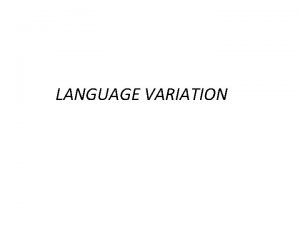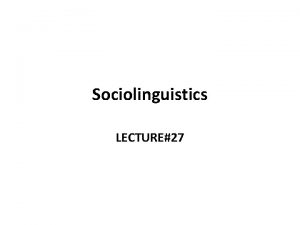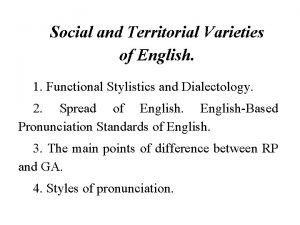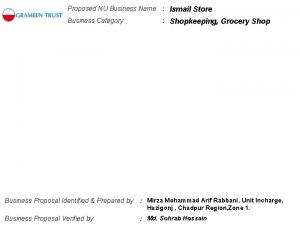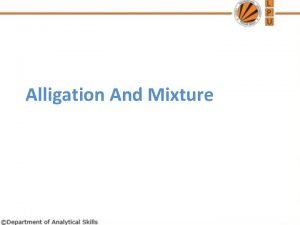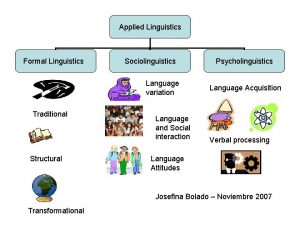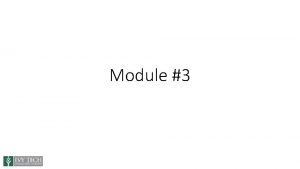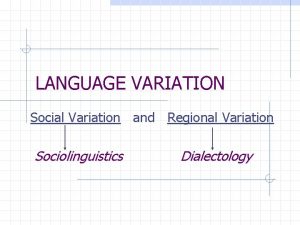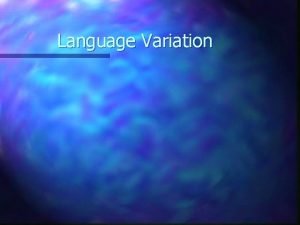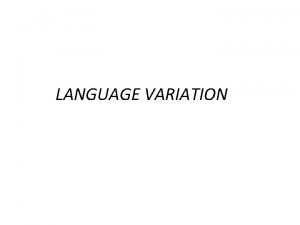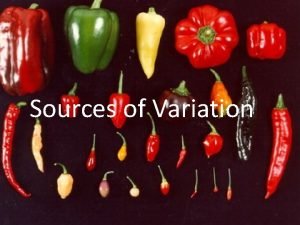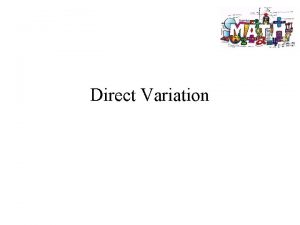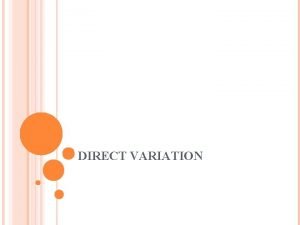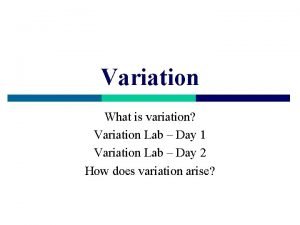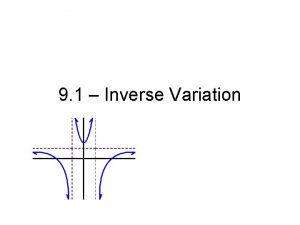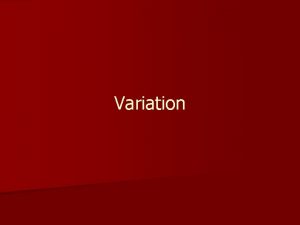Language variation Introduction to Linguistics LANGUAGE VARIETIES Variety















![A case study: [r] variation • New York City, 1972 • In three different A case study: [r] variation • New York City, 1972 • In three different](https://slidetodoc.com/presentation_image/d58d84c192a1f8816b0a345ad15decf4/image-16.jpg)
![In New York speech [r] pronunciation = high prestige. lack of [r] = low In New York speech [r] pronunciation = high prestige. lack of [r] = low](https://slidetodoc.com/presentation_image/d58d84c192a1f8816b0a345ad15decf4/image-17.jpg)

![A case study: [r] variation • In three different department stores – ‘where are A case study: [r] variation • In three different department stores – ‘where are](https://slidetodoc.com/presentation_image/d58d84c192a1f8816b0a345ad15decf4/image-19.jpg)




- Slides: 23

Language variation Introduction to Linguistics

LANGUAGE VARIETIES

Variety 2 Variety 1 Variety 3 Language Variety N

Dialects • A language variety spoken by a group of speakers. • The language variety is characterized by systematic differences from other varieties of the same language.

How do you know that two dialects are the language varieties of the same language? Mutual intelligibility

Nonstandard dialect prestige Standard dialect

slang • “words and phrases peculiar to a particular group and often regarded as non-standard and inferior. “ (Todd & Hancock, International English Usage, 1986) • Stylistic choices in vocabulary • Informal and casual uses of words

• Common slang – TV for television – Fridge for refrigerator – Fan for fanatic – beemer: a BMW – bitch [offensive] : a very unpleasant woman – Aussie : Australian • In-group slang – Gang slangs

jargon • Technical terms in a specific field. – Computer: software, RAM – Jazz music: cool – Baseball: to strike out

Idolect • A peculiar individual style of language variety

FACTORS INFLUENCING VARIATION

Regional and geographic variation

Social factors Socioeconomic variation Age variation Gender variation Ethnic variation

Social classes • Class divisions are (mainly) based on – Wealth – Education – Social status

People from different social classes speak differently Social class Language patterns
![A case study r variation New York City 1972 In three different A case study: [r] variation • New York City, 1972 • In three different](https://slidetodoc.com/presentation_image/d58d84c192a1f8816b0a345ad15decf4/image-16.jpg)
A case study: [r] variation • New York City, 1972 • In three different department stores – ‘where are the women’s shoes? ’ • They are on the fourth floor. – ‘Excuse me, what floor is this? ’ • It’s the fourth floor.
![In New York speech r pronunciation high prestige lack of r low In New York speech [r] pronunciation = high prestige. lack of [r] = low](https://slidetodoc.com/presentation_image/d58d84c192a1f8816b0a345ad15decf4/image-17.jpg)
In New York speech [r] pronunciation = high prestige. lack of [r] = low prestige.

New York City, 1972 Saks = high prestige Macy’s = mid-prestige S. Klein = low prestige
![A case study r variation In three different department stores where are A case study: [r] variation • In three different department stores – ‘where are](https://slidetodoc.com/presentation_image/d58d84c192a1f8816b0a345ad15decf4/image-19.jpg)
A case study: [r] variation • In three different department stores – ‘where are the women’s shoes? ’ • They are on the fourth floor. – ‘Excuse me, what floor is this? ’ • It’s the fourth floor.

Why can’t a woman be more like a man? - My Fair Lady

Reality check men women - • • • talk more than men talk too much are more polite, are indecisive/hesitant complain and nag ask more questions support each other, are more co-operative Living Language (2000) by George Keith and John Shuttleworth • • • swear more don't talk about emotions talk about sport more talk about women and machines in the same way insult each other frequently are competitive in conversation dominate conversation speak with more authority give more commands, interrupt more.

Reality check

QUESTIONS?
 Volume, variety, variation visibility examples
Volume, variety, variation visibility examples Traditional linguistics and modern linguistics
Traditional linguistics and modern linguistics History of applied linguistics
History of applied linguistics Regional variation examples
Regional variation examples Syllable structure examples
Syllable structure examples Which graph represents a function with direct variation
Which graph represents a function with direct variation Examples of direct variation graphs
Examples of direct variation graphs Prediction interval formula
Prediction interval formula Language dialect and varieties in sociolinguistics
Language dialect and varieties in sociolinguistics Language dialect and varieties
Language dialect and varieties Language varieties
Language varieties Language dialect and varieties in sociolinguistics
Language dialect and varieties in sociolinguistics Chapter 6 varieties of drama
Chapter 6 varieties of drama Territorial varieties of english pronunciation
Territorial varieties of english pronunciation Ismail varieties store
Ismail varieties store Crustaceans market form
Crustaceans market form Rice photos
Rice photos Drosera capensis varieties
Drosera capensis varieties Varieties of drama
Varieties of drama Linguistic varieties and multilingual nations
Linguistic varieties and multilingual nations Language variety means
Language variety means Varieties of culture
Varieties of culture A merchant mixes three varieties of wheat costing
A merchant mixes three varieties of wheat costing Disadvantages of suspension therapy
Disadvantages of suspension therapy



